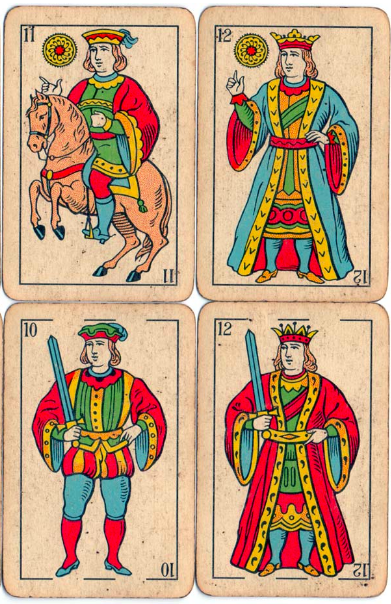King. Queen. Jack..?
https://nowiknow.com/kings-and-queens-are-royals-but-whats-a-jack/#google_vignette
snip
To start, original decks were even less egalitarian than today’s. As seen below (via here), all three face cards depicted men (and, as an aside, there was no separate Ten card). In English, those three ranks were referred to as the King, Knight (on horseback), and Knave (sword, tights, and funny hat). The King was royalty, but the others were support — men in service of the king.
When playing cards spread to France, the French swapped the Knight out for the Queens we have today, for reasons unknown, and the Queen became the preferred representation of the penultimate rank throughout the world shortly thereafter. The Knave, however, remained the same, ranking just below the Knight-turned-Queen.
“Knave” remained the name of choice for about two centuries — at least if you were an upper-crust type. In the English language generally, as Etymology Online notes, “Jack became a generic name applied familiarly or contemptuously to anybody (especially a young man of the lower classes) from late 14th century.” As a knave is “a tricky deceitful fellow” per Merriam-Webster, the two are somewhat interchangeable. It wasn’t the type of language proper peopled used, though, and the card-playing elite were typically proper people. So while some commoners and laborers used the term “Jack” instead of “Knave” while playing cards, it was rare otherwise — and often seen as uncultured if not uncouth. For example, in the 1861 Charles Dickens novel “Great Expectations,” the narrator-protagonist, Pip, is playing cards with his love interest, Estelle. When Pip uses the term “Jack” instead of “Knave,” Estelle uses it as a basis to judge Pip’s worth:
snip
But around the time Great Expectations coincidentally came out, card designs shifted. In order to allow players to fan out their cards, as seen in the image at the top (and you can make the fan much tighter), card makers began printing the cards’ ranks in the corners. The Knave was labeled “Kn,” with the “n” added to distinguish it from “K”-labeled Kings. Card manufacturers looked for a solution, and Jack — despite the low-class connotation it came with — won out. Being proper, it seems, was less important than having an unmistakable “J” in the corner of one’s cards.
